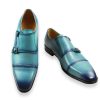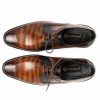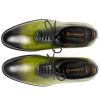How to Spot High-Quality Handcrafted Leather Shoes: The Ultimate Buyer’s Guide
When investing in high-quality handcrafted leather shoes, knowing what to look for can mean the difference between footwear that lasts decades and shoes that fall apart within months. This guide will help you identify authentic craftsmanship, premium materials, and durable construction—ensuring you get the best value for your money.
Why Choose Handcrafted Leather Shoes?
Handmade leather shoes offer superior durability, comfort, and timeless style compared to mass-produced alternatives. Key benefits include:
✅ Better fit – Molds to your foot over time
✅ Longer lifespan – Can be resoled and repaired
✅ Premium materials – Full-grain leather, natural dyes, and sturdy stitching
✅ Unique character – Develops a rich patina with wear
How to Identify High-Quality Handcrafted Leather Shoes
1. Examine the Leather Quality
The type of leather used is the most critical factor in determining shoe quality:
Leather Type Characteristics Best For
Full-Grain Leather Uncorrected, retains natural grain, most durable Dress shoes, boots
Top-Grain Leather Lightly sanded, more pliable, still high-quality Business casual shoes
Genuine Leather Lower layers, often coated, less durable Budget-friendly options
Bonded Leather Made from scraps, glued together, least durable Avoid for long-term wear
🔍 How to Test Leather Quality:
Smell it – Real leather has a rich, earthy scent (not chemical).
Bend it – High-quality leather wrinkles naturally but doesn’t crack.
Check the grain – Full-grain has natural imperfections; corrected grain looks uniform.
Best Example: Full-grain leather shoes are handcrafted with premium hides for lasting durability
2. Check the Construction Method
The way a shoe is assembled determines its longevity and comfort:
A. Goodyear Welt Construction
Most durable – Stitched welt allows for multiple resoles
Water-resistant – Cork filling molds to your foot
Used in luxury brands (e.g., Allen Edmonds, Red Wing)
B. Blake Stitch Construction
Sleeker profile – Single internal stitch for flexibility
Less bulky than Goodyear welt but still durable
Common in Italian dress shoes (e.g., M. Gemi, Koio)
C. Cemented (Glued) Construction
Least durable – Soles detach over time
Common in fast fashion – Avoid for long-term wear
🔍 How to Spot Quality Construction:
✔ Look for visible stitching around the sole.
✔ Avoid shoes with only glue holding the sole.
Best Example: Welted boots are built to last decades
3. Inspect the Stitching & Detailing
Handmade shoes feature tight, even stitching with high-quality thread. Signs of poor craftsmanship:
❌ Loose threads
❌ Uneven seams
❌ Glue marks
🔍 What to Look For:
✔ Double or triple stitching in stress areas (e.g., toe cap, heel)
✔ Hand-painted edges – Indicates artisanal finishing
Best Example: Hand-stitched Oxfords showcase impeccable detailing.
4. Assess the Sole Material
The sole impacts comfort, grip, and longevity:
Sole Type Pros Cons
Leather Sole Breathable, molds to foot, elegant Slippery when new, requires breaking in
Rubber Sole Grippy, comfortable immediately Less breathable, wears faster
Vibram® Sole Durable, weather-resistant Bulkier than leather
🔍 Best Choice:
Dress shoes → Leather soles (can be fitted with rubber topys)
Casual/boots → Vibram or Dainite rubber soles
Best Example: Helm Boots use Vibram soles for rugged durability
5. Look for a Leather Lining & Insole
High-end shoes feature breathable leather lining for comfort:
✔ Full leather lining – Prevents sweat buildup
✔ Cork footbed – Molds to your foot over time
❌ Synthetic lining – Traps moisture, less durable
Comparison Chart: Handcrafted vs. Mass-Produced Shoes
Feature Handcrafted Shoes Mass-Produced Shoes
Leather Full-grain, natural imperfections Corrected grain, plastic-coated
Construction Goodyear welt, Blake stitch Glued, cheap stitching
Sole Leather or Vibram rubber Thin synthetic rubber
Lining Full leather Fabric or synthetic
Durability 10+ years with care 1-2 years before breakdown
Price $200-$1000+ $50-$150
Final Tips for Buying Handcrafted Leather Shoes
Prioritize resoleability – Goodyear-welted shoes last longer.
Invest in care products – Cedar shoe trees, conditioner, and polish extend lifespan.
Avoid “vegan leather” for longevity – Most are plastic-based and degrade quickly.
By following this guide, you’ll confidently identify high-quality handcrafted leather shoes worth the investment. 🚀
Want more? Explore our Best Handmade Shoe Brands for curated recommendations.
Citations & External References
- History Of Handcrafted Leather Shoes – Jose Real
- The Cordwainer – Michael Carver — Historical Interpreter/Reenactor
- The History of Leather Shoes – Real Leather. Stay Different.
- The Honourable Cordwainers’ Company
- Cordwainer, Shoemaker, Cobbler? – Jane Austen’s London
- Cordwainer – Wikipedia
- Shell Cordovan – Wikipedia
- Shoemaking – Wikipedia
- Made in Northampton: British Shoemaking – Country and Town House
- The History of Northamptonshire Shoemaking – Heddels
- The Storied Legacy of Marche – Gianni Gallucci
- Scarpe Montegranaro – Franceschetti
- Santoni Shoes – Stenstroms Store
- Carmina Shoemaker – Reddit AMA
- Carmina Shoemaker – Gentlemen’s Footwear
- A Step Into the Craft – Carmina Shoemaker
- Santoni Meraviglia: 50th Anniversary
- Why Are Italian Handmade Shoes Important? – Studia in Italia
- Handmade Shoes – FEIT












